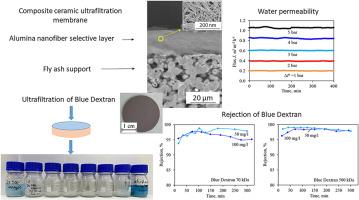利用粉煤灰微球和氧化铝纳米纤维开发复合超滤膜,高效去除水溶液中的染料
IF 5.1
2区 材料科学
Q1 MATERIALS SCIENCE, CERAMICS
引用次数: 0
摘要
本研究提出了一种新型超滤陶瓷膜,其支撑层以细粉煤灰微球为基础,选择层以氧化铝纳米纤维为基础,并添加了硅酸铝粘合剂。支撑层和选择层的平均孔径分别为 0.46 μm 和 29 nm。膜的抗压强度为 96 兆帕,透水性为 207 l m-2 h-1 bar-1。结果表明,粘合剂能使选择层结构稳定,并能粘附在支撑物上。随着粘合剂含量的增加,透水性也随之增加,达到最大值后略有下降。所开发的膜用于超滤分子量为 70 kDa 和 500 kDa、浓度为 50 和 100 mg/L 的蓝色右旋糖酐染料水溶液。在跨膜压力为 4 巴时,染料截留率在 97-99 % 之间,而渗透通量为 100-140 升/米-2 小时-1。染料截留在初始阶段是通过吸附发生的,吸附导致孔径变窄。此外,染料过滤主要是由于尺寸效应。所提出的膜可用于去除废水中的染料,还可通过碳涂层进行化学修饰,用于电化学辅助超滤。所开发的方法促进了热能废物的回收利用,并引入了结合废物和合成原材料生产低成本陶瓷膜的新方法。本文章由计算机程序翻译,如有差异,请以英文原文为准。


Development of composite ultrafiltration membrane from fly ash microspheres and alumina nanofibers for efficient dye removal from aqueous solutions
In this work, a novel type of ultrafiltration ceramic membranes with the support based on fine fly ash microspheres and selective layer based on the alumina nanofibers with an aluminosilicate binder is proposed. The average pore sizes of the support and selective layer are 0.46 μm and 29 nm, respectively. The membrane is characterized by the compressive strength of 96 MPa and water permeability of 207 L m−2 h−1 bar−1. It is shown that the binder provides structural stability of selective layer and adhesion to the support. With increasing the binder content, the water permeability increases, reaches maximum, and then slightly decreases. The developed membranes are used for ultrafiltration of Blue Dextran dyes aqueous solutions with molecular weights of 70 kDa and 500 kDa and concentrations of 50 and 100 mg/L. The dyes rejection varies in the range 97–99 %, while the permeate flux is 100–140 L m−2 h−1 at the transmembrane pressure of 4 bars. The dye retention occurs via adsorption at the initial stage, which leads to the narrowing of pore size. Further, the dye filtration proceeds mainly due to size effects. The proposed membranes can be employed for dye removal from wastewater, and also allow chemical modification by carbon coating to be employed in electrochemically assisted ultrafiltration. The developed methodology promotes the recycling of thermal energy waste and introduces novel approaches to combine waste and synthesized raw materials in the production of low-cost ceramic membranes.
求助全文
通过发布文献求助,成功后即可免费获取论文全文。
去求助
来源期刊

Ceramics International
工程技术-材料科学:硅酸盐
CiteScore
9.40
自引率
15.40%
发文量
4558
审稿时长
25 days
期刊介绍:
Ceramics International covers the science of advanced ceramic materials. The journal encourages contributions that demonstrate how an understanding of the basic chemical and physical phenomena may direct materials design and stimulate ideas for new or improved processing techniques, in order to obtain materials with desired structural features and properties.
Ceramics International covers oxide and non-oxide ceramics, functional glasses, glass ceramics, amorphous inorganic non-metallic materials (and their combinations with metal and organic materials), in the form of particulates, dense or porous bodies, thin/thick films and laminated, graded and composite structures. Process related topics such as ceramic-ceramic joints or joining ceramics with dissimilar materials, as well as surface finishing and conditioning are also covered. Besides traditional processing techniques, manufacturing routes of interest include innovative procedures benefiting from externally applied stresses, electromagnetic fields and energetic beams, as well as top-down and self-assembly nanotechnology approaches. In addition, the journal welcomes submissions on bio-inspired and bio-enabled materials designs, experimentally validated multi scale modelling and simulation for materials design, and the use of the most advanced chemical and physical characterization techniques of structure, properties and behaviour.
Technologically relevant low-dimensional systems are a particular focus of Ceramics International. These include 0, 1 and 2-D nanomaterials (also covering CNTs, graphene and related materials, and diamond-like carbons), their nanocomposites, as well as nano-hybrids and hierarchical multifunctional nanostructures that might integrate molecular, biological and electronic components.
 求助内容:
求助内容: 应助结果提醒方式:
应助结果提醒方式:


